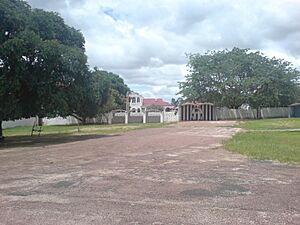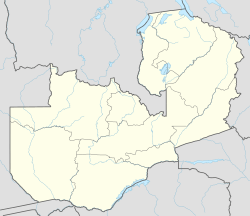Mongu facts for kids
Quick facts for kids
Mongu
|
|
|---|---|
|
City
|
|

Litunga's Winter Palace
|
|
| Country | |
| Province | Western Province |
| District | Mongu District |
| Elevation | 3,340 ft (1,018 m) |
| Population
(2010)
|
|
| • Total | 179,585 |
Mongu is an important city in Zambia, a country in southern Africa. It is the capital of the Western Province. Long ago, it was also the capital of a historic state called Barotseland. In 2010, about 179,585 people lived there. Mongu is also where the Litunga, who is the King of the Lozi people, lives. The current king is His Majesty Lubosi Imwiko III.
Contents
History of Mongu
The name Mongu comes from the Lozi word mungu. This word refers to how pumpkins grow and are produced in the area. Mongu was the main city for the Lozi kings of Barotseland from the 1700s until 1911.
Later, when the British ruled, Mongu became a district. It was called Mongu-Lealui. This change was made by Hubert Winthrop Young, who was the Governor of Northern Rhodesia. After Zambia became an independent country in 1964, Mongu became a rural council. In 1980, it was made into a District Council. Today, Mongu is still a mostly rural city. Most of the businesses there are related to agronomy, which is the science of farming.
Where is Mongu? (Geography)
Mongu is located on a slightly raised piece of land. This land is on the eastern side of the Barotse Floodplain. This floodplain is about 30 kilometers wide and is part of the Zambezi River. The river runs from north to south. During the wet season, the floodplain fills with water, reaching right up to the town.
The city is about 15 kilometers away from the main part of the river. Mongu has a small harbor. In the dry season, a 35-kilometer route connects the harbor to the river. This route includes a canal and a winding channel. The entire area around Mongu is flat and sandy. The dry land is usually not much higher than the floodplain, only about 50 meters.
Who Lives in Mongu? (Demographics)
Mongu is the main home for the Lozi people. They are also known as the Barotse. The Lozi people speak a language that is partly from the Makololo language. It is also related to the South African Sesotho language.
The Lozi ruler, the Litunga, has two palaces. One is a dry season palace located 12 kilometers northwest at Lealui. This palace is on the floodplain. The other is a flood season palace on higher ground at Limulunga, about 17 kilometers north. A special ceremony called Kuomboka happens when the royal court moves between these two palaces.
Towards the end of the 1700s, many Mbunda people from Angola came and settled in this area.
Weather in Mongu (Climate)
Mongu gets an average of 945 millimeters of rain each year. This rain falls during the rainy season, which lasts from late October to April. The floodwaters usually arrive by January and reach their highest point in April. By June, the water is gone. This leaves the floodplain covered with new green grass. About 250,000 people move onto the floodplain to graze their cattle, catch fish, and grow crops in small gardens.
Mongu is hot from September to December. The average highest temperature in October is 35.4 degrees Celsius. It is cooler from May to August. The average highest temperature in June is 26.9 degrees Celsius, and the average lowest is 10.3 degrees Celsius.
| Climate data for Mongu (1991–2020) | |||||||||||||
|---|---|---|---|---|---|---|---|---|---|---|---|---|---|
| Month | Jan | Feb | Mar | Apr | May | Jun | Jul | Aug | Sep | Oct | Nov | Dec | Year |
| Record high °C (°F) | 39.0 (102.2) |
36.9 (98.4) |
38.2 (100.8) |
39.0 (102.2) |
34.7 (94.5) |
33.8 (92.8) |
35.5 (95.9) |
40.5 (104.9) |
41.5 (106.7) |
41.5 (106.7) |
39.8 (103.6) |
38.0 (100.4) |
41.5 (106.7) |
| Mean daily maximum °C (°F) | 29.8 (85.6) |
29.7 (85.5) |
30.2 (86.4) |
30.9 (87.6) |
29.6 (85.3) |
27.8 (82.0) |
27.9 (82.2) |
31.1 (88.0) |
34.7 (94.5) |
35.6 (96.1) |
32.5 (90.5) |
30.3 (86.5) |
30.8 (87.4) |
| Daily mean °C (°F) | 24.7 (76.5) |
24.6 (76.3) |
24.7 (76.5) |
23.9 (75.0) |
21.7 (71.1) |
19.3 (66.7) |
19.1 (66.4) |
22.1 (71.8) |
25.9 (78.6) |
27.5 (81.5) |
26.0 (78.8) |
24.8 (76.6) |
23.7 (74.7) |
| Mean daily minimum °C (°F) | 19.5 (67.1) |
19.5 (67.1) |
19.2 (66.6) |
16.9 (62.4) |
13.7 (56.7) |
10.7 (51.3) |
10.2 (50.4) |
13.1 (55.6) |
17.0 (62.6) |
19.4 (66.9) |
19.4 (66.9) |
19.3 (66.7) |
16.5 (61.7) |
| Record low °C (°F) | 12.9 (55.2) |
11.5 (52.7) |
9.1 (48.4) |
7.5 (45.5) |
2.7 (36.9) |
−1.6 (29.1) |
0.3 (32.5) |
−1.6 (29.1) |
7.4 (45.3) |
9.2 (48.6) |
11.1 (52.0) |
13.8 (56.8) |
−1.6 (29.1) |
| Average precipitation mm (inches) | 229.3 (9.03) |
210.8 (8.30) |
141.0 (5.55) |
29.8 (1.17) |
5.1 (0.20) |
0.3 (0.01) |
0.0 (0.0) |
0.0 (0.0) |
2.1 (0.08) |
20.3 (0.80) |
95.1 (3.74) |
227.7 (8.96) |
965.7 (38.02) |
| Average relative humidity (%) | 78.9 | 80.0 | 77.6 | 68.3 | 58.9 | 53.6 | 47.3 | 39.7 | 34.2 | 48.5 | 64.2 | 76.8 | 60.7 |
| Mean monthly sunshine hours | 198.4 | 179.2 | 226.3 | 267.0 | 306.9 | 297.0 | 313.1 | 313.1 | 288.0 | 266.6 | 216.0 | 195.3 | 3,066.9 |
| Source: NOAA (humidity, sun 1961–1990) | |||||||||||||
Nature Around Mongu (Ecology)
The area around Mongu has three main types of natural environments, called ecoregions.
- The floodplain is made of Zambezian flooded grasslands.
- The higher, dry ground is a mix of Central Zambezian Miombo woodlands and Cryptosepalum dry forests.
To the east, the soil is very sandy. There are many salt pans that dry out in the dry season. Beyond the Lui River, there is no surface water. This area has scrubby miombo woodland and is almost empty of people.
What People Do in Mongu (Economy)
Mongu is at the end of the 590-kilometer Lusaka–Mongu Road from Lusaka. Driving this road usually takes about 8 to 11 hours. Another important road is the M10 Road. This road connects Mongu to the border with Namibia at Katima Mulilo and to Livingstone.
The city is well-known for its beautiful basket and carpet weaving. Mongu also produces some of the best mangoes and fish in Zambia, especially the tiger fish. It is also a major area for growing rice in Zambia.
Mongu has a cathedral and a water tower. There are several places to shop and socialize. The town also has a large market and an airport. Mongu Airport is mostly used by the Zambian Air Force and the United Nations. They use it to help transport Angolan refugees back to their home country. You can also visit the Nayuma Museum in Mongu.
See also
 In Spanish: Mongu para niños
In Spanish: Mongu para niños



